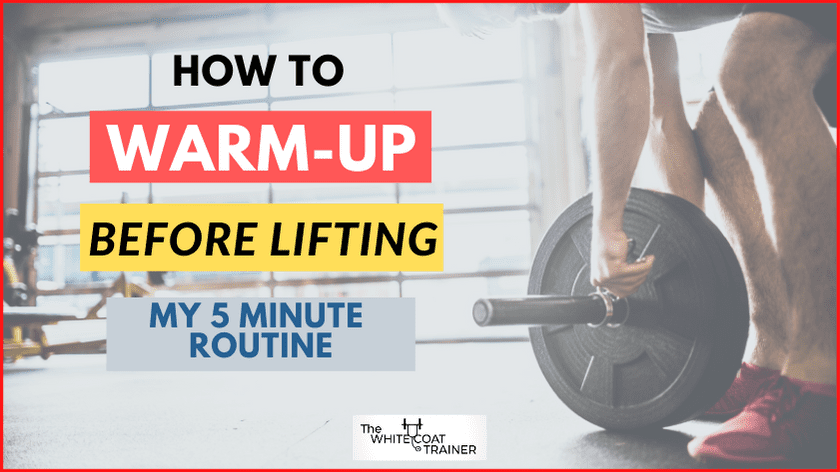Do you want to know how you should warm-up before lifting?
You are in the right place.
In this post, you will learn:
- What happens if you don’t warm up before lifting,
- How you should warm up before lifting, and
- The three types of warm-ups everyone needs to do
Keep reading.

Do You Need To Warm-up Before Lifting?
Yes, it is necessary to physically warm up before lifting weights to prime your body to lift and reduce your risk of injury.
A pre-workout warm-up serves to:
- Increase your basal body temperature,
- Promote increased circulation and blood flow to your joints and muscles,
- Increase mobility,
- Activate dormant muscles, and
- Prime your nervous system to recruit more muscle motor units
What Happens If You Don’t Warm Up Before Lifting Weights?
If you don’t warm up before lifting, you unnecessarily increase your musculoskeletal injury risk.
Your body is not ready to recruit muscle fibers at high levels of intensity at such short notice. A proper warm-up will increase the elasticity of your muscles, lubricate your joints, and improve muscular contractions.
How Long Should I Warm up Before Lifting Weights?
A well-designed warm-up should take no longer than 5 minutes.
As such, you should tailor the warm-up to the movements you will be performing that day. You can turn it into a full-body warm-up or a body-specific warm-up.
Believe it or not, you can fit an entire full-body workout in 35 minutes, including a warm-up routine.
Here’s how we do it.
How Should I Warm Up Before Heavy Lifting?
Many people think of a warm-up as a 5-minute jog on the treadmill. Sure, this will get your basal body temperature up and increase your circulation, but this pales in comparison to what a warm-up should be.
A proper lifting warm-up should include three things:
| Warm-Up Exercise | Purpose |
|---|---|
| General activation drills | To activate key muscle groups in the core |
| Dynamic exercises | To improve muscle elasticity and range of motion |
| Specific activation drills | To prime specific muscle groups for lifting |
Let’s go over each one by one.
The 3 Most Important Components of a Warm-Up Routine
There are three types of warm-up exercises that you should do before lifting weights.
Here is my recommended routine:
- 1-2 General Activation drills,
- 2 Dynamic Warm-Up Exercises and
- 2 Specific Activation drills
Let’s go over each one individually.
1. General Activation Drills
The purpose of general activation drills is to turn on two essential muscle groups dormant in most people.
Like most people, you probably need to activate your glutes and the abdominal muscles.
We live in a society that promotes sitting all day. As a result, these two muscle groups lay dormant for several hours every day.
Inactivation of these muscles usually contributes to some of the four poor postures we describe in “You Probably Have Bad Posture- Here’s How to Tell.”
Why Do The Glutes and Abs Need To Be Activated?
The glutes and the abs are critical components that need activation before starting a workout.
Why?
The glutes and the abs are required to perform every functional exercise.
If you attempt to perform compound exercises without engaging your core, you will end up in suboptimal positions, which increases your risk of injury.
Examples of Warm-Up Exercises for General Activation
Here are a few examples of drills that activate the glutes and abdominals simultaneously:
- Birddogs
- Planks
- Side Planks
- Glute Bridges
Squeeze your glutes and brace your core as hard as possible for a five-count when performing these drills. Your glutes and abs should be on fire after doing one or more of these drills.
If you do not squeeze as hard as you can, you are just wasting your time.
Relax and repeat the drill for ~ five repetitions.
Often, one to two activation drills is enough.
2. Dynamic Warm-Up Exercises
The next component of our warm-up is the dynamic warm-up exercise.
Dynamic exercises stretch or elongate any muscle fibers that are either tight or stiff.
Generally, when people hear “stretching,” they think about static stretching. Static stretching is when you hold one fixed position for a specific duration of time.
Dynamic exercises are different.
In a dynamic warm-up, you oscillate into and out of a full range of motion exercise.
Let me show you some examples.
Examples of Dynamic Warm-Up Exercises
Here are some dynamic movements you can do and the resistance exercise they can help (in parenthesis).
- Chest Opener (Bench press, Overhead press)
- Banded Shoulder Dislocations (Bench Press, Overhead press)
- Bent Over Double Lat Stretch (Overhead press, Bench Press)
- Deep Squat to Stands (Squats, Deadlifts)
- Lunges with Kneeling Hip Flexor Stretch (Squats, Deadlifts)
Spend 30-45 seconds in each position and oscillate into different nooks and crannies at the end range position.
Dynamic stretches should be tailored to your particular restrictions and the movements you will perform that day.
Also, it is crucial to identify stretches that correspond to your problem areas to get the most benefit.
Check out our post on how flexible are you? to determine if you need to stretch any problem areas you may have.
3. Specific Activation Drills
The third and final component of the warm-up is specific activation drills.
Specific activation drills turn on the primary muscle groups for the movement(s) you are about to perform. You should perform these drills with a light weight or just your bodyweight for 1-2 sets of 10+ repetitions.
Examples of Specific Warm-Up Exercises
Here are some examples of specific activation drills, including the exercise they may help:
- Bodyweight Squats (Squats, Deadlifts)
- Duck walks with a band around your knees (Squats, Deadlifts)
- Dumbbell lateral raises (Bench press, Overhead press)
- Dumbbell Overhead presses (Bench press, Overhead press)
- Push-ups (Bench press, Overhead press)
As you can see, each drill targets specific muscles before a weight training session.
Putting It All Together: How To Warm Up In 5 Minutes Before A Workout
Okay, how do we use those three warm-up components to design a 5-minute pre-workout warmup?
It starts with knowing the exercises you will use for general activation, dynamic stretching, and specific activation.
Transition from your general activation drills to your dynamic stretches and immediately into your specific activation drills.
It is essential to do this at a quick pace to increase your body temperature and your heart rate while doing these exercises.
It should only take you 5 minutes to perform.
This is the warm-up routine you should use before performing The Best Workout Template for Busy Professionals or any other physical activity.
Example of A 5 Min Upper Body Warm-Up Before Lifting
- Birddogs x 45 seconds (General Activation)
- Plank to Side Plank x 45 seconds (General Activation)
- Banded Shoulder Dislocations x 1 minute (Dynamic Stretch)
- Upward to Downward Dog x 1 minute (Dynamic Stretch)
- Incline Push-ups x 45 seconds (Specific Activation)
- Dumbbell Lateral Raise x 45 seconds (Specific Activation)
Example of A 5 Min Lower Body Warm-Up
- Birddogs x 45 seconds (General Activation)
- Glute Bridge x 45 seconds (General Activation)
- Deep Squat to Stands alternating x 1 minute (Dynamic Stretch)
- Kneeling Hip Flexors Stretch Pulses x 1 minute on each side (Dynamic Stretch)
- Duck Walks x 45 seconds (Specific Activation)
Example of A 5 Min Full-Body Warm-Up
- Glute Bridges x 45 seconds (General Activation)
- Plank to Side Plank x 45 seconds (General Activation)
- Deep Squat to Stands x 1 minute (Dynamic Stretch)
- Banded Shoulder Dislocations x 1 minute (Dynamic Stretch)
- Bodyweight Squats x 30 seconds (Specific Activation)
- Incline Push-ups x 30 seconds (Specific Activation)
Is a 5 Minute Warm-Up Enough?
Yes, 5 minutes is enough time to prepare your body for exercise adequately. You must select warm-up exercises that are specific to your workout of the day and target your unique restrictions.
Also, it is vital to move quickly from one warm-up set to the next to increase your heart rate and elevate your body temperature.
What About Warm-Up Sets?
Once you are able to lift heavy weights, you will need to use warm-up sets before attempting the weight that is considered your ‘working set.’
For example, if you are scheduled to squat 225 lbs for 8 reps today, you wouldn’t go to the gym, perform your 5-minute pre-workout warmup and then load up 225 lbs on the bar and go.
It is in your best interest to perform a few warm-up sets first.
You should always aim to do ~2-3 warm-up sets before your working weight with a progressively increasing load while decreasing the number of repetitions you do on each set.
In the above example, you can do the following:
- 45 lb squat x 8 reps
- 135 lb squat x 5 reps
- 185 lb squat x 3 reps
- Working Weight at 225 lbs
If you are lifting lighter weights, you can get away with just one warm-up set.
In addition, you can use the lighter warm-up sets as part of your Specific Muscle Activation drill!
Other Related Questions
Should You Stretch Before Lifting?
If there is one thing that your pre-workout warmup should not include, it’s static stretching.
Some studies have shown that static stretches can decrease a muscle’s power production before physical activity.
In addition, pre-workout static stretching does nothing to address why you are warming up in the first place.
Static stretching won’t:
- increase your body temperature,
- activate your dormant core muscles,
- nor decrease your risk of injury.
This does not mean that you should not perform static stretching.
Static stretching has many benefits, which we describe in When Is Stretching Necessary and When Is It A Waste of Time.
The best time to static stretch is either post-workout or before bed after a warm shower.
Here are our nine favorite stretches:

How long do muscles stay warmed up?
Your muscles will remain warm for approximately 15-30 minutes following a proper warm-up routine. Therefore, you must begin your workout right away and avoid long periods of inactivity.
Should I Get My Heart Rate Up Before Lifting Weights?
It is a good idea to increase your heart rate before lifting weights to improve circulation and increase your basal body temperature.
You can accomplish this by moving through your warm-up exercises quickly with no periods of rest.
Are Push-ups A Good Warm Up?
Push-ups are a great way to warm up the upper body as long as they aren’t difficult for you to perform. Ideally, a warm-up exercise should not be challenging.
If you struggle to perform standard push-ups, you can do incline push-ups instead.
Is Running A Good Warm Up Before Lifting?
Light cardio is a decent way of increasing your core temperature ad elevating your heart rate before a lifting session. However, it does not prime your body for exercise as well as a proper warm-up.
Instead of jumping on a treadmill before lifting weights, using the 5-minute warm-up routine above is more efficient.
What Kind Of Workout Should I Do Following This Warm-Up?
The warm-up is just the beginning.
Now that you have a killer 5-minute warm-up, you need to follow it up with a 30-minute exercise program.
That is why we created The WCT Strength Program For Busy Professionals. It is a complete 15-week training template that focuses on all of the strategies you need to get stronger, build muscle, and burn fat.
There are two templates – a male and a female version.

The Bottom Line on Warming Up Before Working Out
Is this the only way to warm up? Of course not.
There are several strategies you can use to accomplish the same goal. Either way, a warm-up is an essential part of a weight lifting program.
A warm-up will prime your target muscles and joints before doing compound exercises if done correctly.
Do not get caught lifting weights until you have performed an appropriate warm-up.
Come on; it’ll only take 5 minutes.
Next, You Should Read:
- How Many Exercises Per Workout Should I Do?
- How To Workout In 30 Minutes A Day
- What Exercises Should I Include In My Workout?
Now we turn it over to you.
Do you generally skip your warm-ups?
How long do you spend on it?
What exercises do you typically include in your warm up?
Comment below and let us know!

Alex Robles, MD, CPT / Brittany Robles, MD, MPH, CPT
Alex & Brittany Robles are physicians, NASM Certified Personal Trainers, and founders of The White Coat Trainer: a resource dedicated to improving the health and fitness of busy professionals using time-efficient strategies. Their advice has been featured in My Fitness Pal, Prevention, Livestrong, Reader’s Digest, Bustle, The Active Times, and more. Learn more about them here.
References:
- Woods K, Bishop P, Jones E. Warm-up and stretching in the prevention of muscular injury. Sports Med. 2007;37(12):1089-99. doi: 10.2165/00007256-200737120-00006. PMID: 18027995.
- Safran MR, Seaber AV, Garrett WE Jr. Warm-up and muscular injury prevention. An update. Sports Med. 1989 Oct;8(4):239-49. doi: 10.2165/00007256-198908040-00004. PMID: 2692118.
- Simic, L., Sarabon, N., & Markovic, G. (2013). Does pre-exercise static stretching inhibit maximal muscular performance? A meta-analytical review. Scandinavian journal of medicine & science in sports, 23(2), 131–148. https://doi.org/10.1111/j.1600-0838.2012.01444.x
